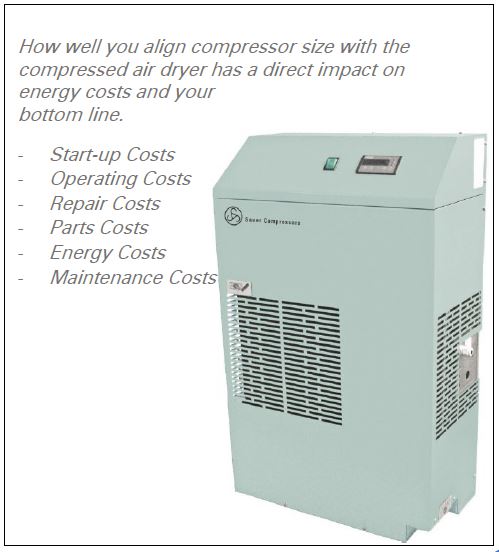A Brief Introduction to Compressed Air Dryers
There is an endless supply of information on compressed air dryers if you look online for options. Trying to decipher it all can quickly eat up time and put you in information overload. But it is critical to make the right choice for your application. The type of dryer you chose affects not only your process but operation and maintenance costs. Do not forget your bottom line too.
Sauer Compressors USA has developed this Compressed Air Dryer Guide to help you decipher all the information. The document covers key considerations, advantages, disadvantages of refrigerated, desiccant, and membrane compressed air dryers.
Start with the Basics
Let us begin by reviewing a few of the basics to create a background for those unfamiliar and refresh others’ minds. Compressed air dryers use air that has been compressed. Compression occurs when the molecules are forced to move faster and closer together into a smaller space. The act increases the temperature in the air.
All compressed air contains naturally occurring moisture from the air used in compression. The hot air from compression can hold this moisture. If the gas cools at any point in the system, the moisture will condense into the air stream. That moisture can be a problem, and even more so if your application needs moisture-free air. Compressed air dryers separate water vapor or moisture from process air by cooling the air, adsorbing the moisture, or permeation.
As compressed air cools, water vapor condenses, steam is collected, and moisture is removed. Moisture removal reduces your odds of having problems like rust, scaling, or freezing in pipes, along with malfunctions, excessive wear, or poor performance by the equipment. You also avoid the slow or inconsistent operation of valves and cylinder control instruments. Removing condensed liquids from the gas will, in turn, remove oil liquids, which are present with oil-lubricated compressor systems, as well.
Essential Areas to Consider
There are several essential areas to consider when comparing compressed air dryers. They include dew point, compressor size, operating pressure, operating costs, etc. Performance is measured by flow rate in Standard Cubic Feet per Minute (SCFM), and dew point expressed as a temperature (Pressure Dew Point), read at operating pressure of the compressor equipment. Use the following for first-level comparisons.
- Know your dew point
Your goal is to keep your dew point temperature lower than your compressed air temperature. It is crucial because you want air dry enough so that no moisture will condense in your airlines. - Look at compressor size
Determine the best compressor size by looking at your dryer needs. Using a larger compressor than needed will lead to higher energy costs. You must ensure that the dryer selected is compatible with your compressor flow and operating pressure. - Consider your operating pressure
A top reason dryers fail is because they have not been sized correctly for the processes
operating pressure. Determine the right size by looking at the flow rate and pressure of the air moving through the dryer. Find the balance between your dryer being able to handle larger CFM amounts without losing performance.
To keep reading, download the full guide here.


You must be logged in to post a comment.